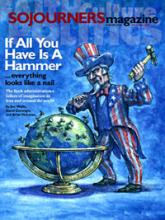A 34-year-old yard-sale shopper in Ohio, sifting through a cardboard box of items she’d recently purchased, got something more than she bargained for. Taped to the back of a painting of dogs playing cards, she discovered two pages of single-spaced text, ostensibly from a 22nd-century history book, describing our immediate future. The pages were numbered 88 to 91 (front and back), each with the following headers on alternate pages: A Brief History of the 21st Century, Chapter 11: The Former United States.
... since most English-language records were destroyed in the chaos that marked the end of the Hot Wars in 2051.
The difficult years 2001 to 2008 set the stage for this turbulent Hot War period. The United States, confident in its role as sole planetary superpower but anxious about the threat of jihadist terrorism in the aftermath of the homeland terrorist incident of 2001, staged three major military projects during these years.
First, it invaded Afghanistan with mixed results. It successfully forced regime change, ejecting the jihadist party there, but it failed to help the invaded country reunify and rebuild adequately, nor did it apprehend the key leaders of various jihadist groups hiding there, including the planners of the 2001 incident.
Before completing the Afghanistan project, U.S. leaders next turned their attention to a second invasion, this one in Iraq, resulting in another regime change but, again, not in lasting peace. In fact, both regions remain destabilized today as a result of these ill-conceived and poorly executed invasions, torn by ongoing civil wars among competing warlords, many of whom provide safe havens for various remnants of 21st-century jihadist networks.
Read the Full Article

